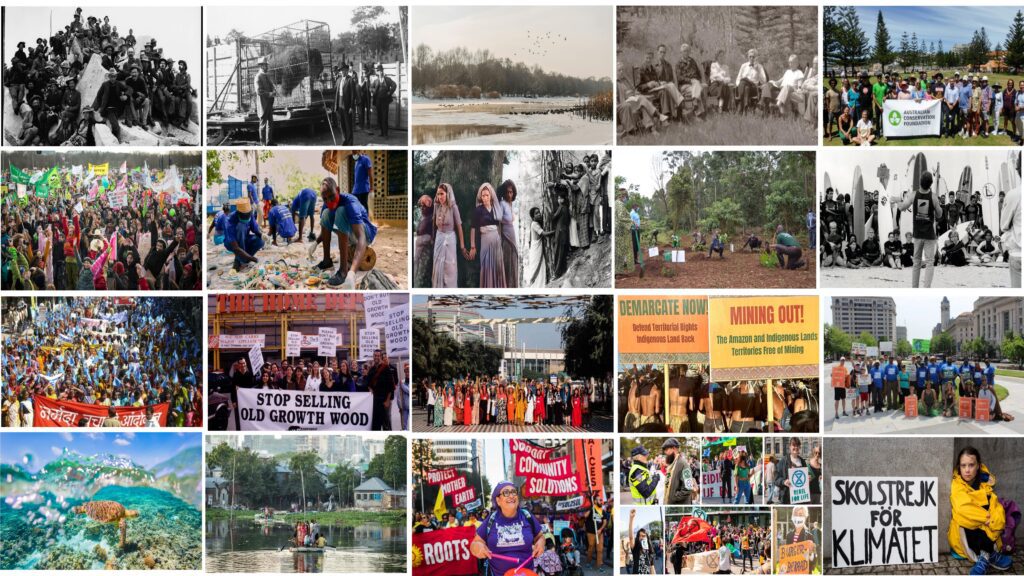
Many environmental movements have been started to protect the environment from various threats. Whereas, some of the movements are working together to shape the world through various activities and awareness. From local efforts to global agreements, each movement plays a big part in helping us to take care of our planet for the future. Here are the stories behind 20 such major environmental movements of the world. It also includes inspiration, achievements, activities and shared effort to keep our planet safe for upcoming generations.
Table of Content
- Sierra Club
- Wildlife Conservation Society
- BirdLife International
- The Wilderness Society
- Australian Conservation Foundation
- Greenpeace
- Ocean Conservancy
- Chipko Movement
- Green Belt Movement
- Surfrider Foundation
- Narmada Bachao Andolan
- Rainforest Action Network
- Rainforest Foundation
- Amazon Watch
- Dogwood Alliance
- Great Barrier Reef Foundation
- Environmental Justice Foundation
- 350.org
- Extinction Rebellion
- Fridays for Future
1. Sierra Club
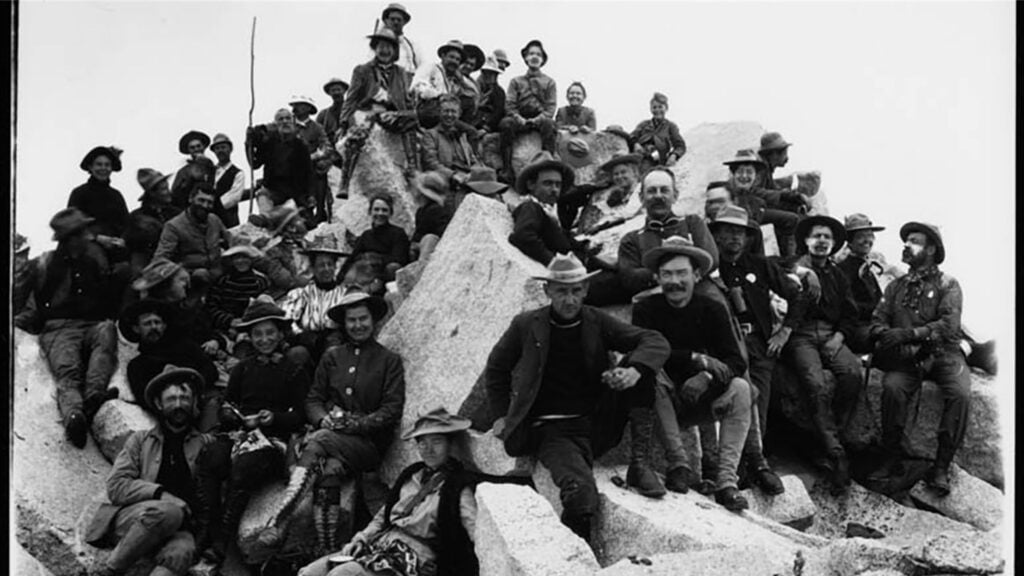
- Year Started: 1892
- Place of Origin: United States
- Founder and Leadership: John Muir
- Objectives: To conserve and protect the natural environment, advocate for sustainable practices, promote responsible outdoor recreation and provide environmental education. They also help in legal action for resource protection and to raise public awareness.
A nature lover, John Muir was worried about how factories and cities were changing the land in America. Muir and some friends started the Sierra Club to save the Sierra Nevada mountains in California. They helped to create Yosemite National Park in 1890, which was the first national park in the United States. The Sierra Club does a lot to take care of nature, speak up for outdoor fun, and make sure the Earth stays safe. Among 20 major environmental movements of the world, the Sierra Club is the first recognised in the world to protect the environment.
Activities and Initiatives
- Conservation as a Core Value: At the heart of the Sierra Club’s philosophy is a deep-seated commitment to conservation. The organization believes in balancing human needs with environmental preservation and advocating for policies that safeguard natural habitats. In addition, they promote clean energy and help to mitigate the impact of human activities on the planet.
- Diverse Advocacy and Campaigns: The Sierra Club engages in a spectrum of environmental causes. They are addressing issues ranging from air and water quality to wildlife protection and climate change. The organization’s campaigns are marked by a combination of grassroots activism, legal advocacy, and also public awareness initiatives.
- Promotion of Biodiversity and Public Lands: The Sierra Club has been instrumental in the establishment and expansion of national parks and protected areas. The organization actively supports initiatives to conserve critical habitats, ensuring that future generations can experience the richness of the natural world.
- Leadership and Influential Figures: Over the years, the Sierra Club has been steered by influential leaders such as John Muir, David Brower, and more. These figures have played pivotal roles in shaping the organization’s strategies, contributing to its longevity and impact on the environmental movement.
- Renewable Energy Advocacy: In response to the modern challenge of climate change, the Sierra Club has shifted focus to renewable energy advocacy. The organization promotes clean energy solutions and fights against fossil fuel projects. In addition, they actively support the transition to a sustainable, low-carbon future.
Major Achievements
- The Sierra Club’s dedication to legal action has resulted in landmark victories that have shaped environmental policy. Despite challenging destructive development projects, they are fruitfully advocating for stronger environmental regulations. In addition, their legal work has had a big impact on the way we think about protecting nature.
- They played a crucial role in the passage of the Wilderness Act of 1964 and the Clean Air Act of 1970. The organization has also been active in legal battles to protect public lands and challenge environmentally harmful policies.
2. Wildlife Conservation Society
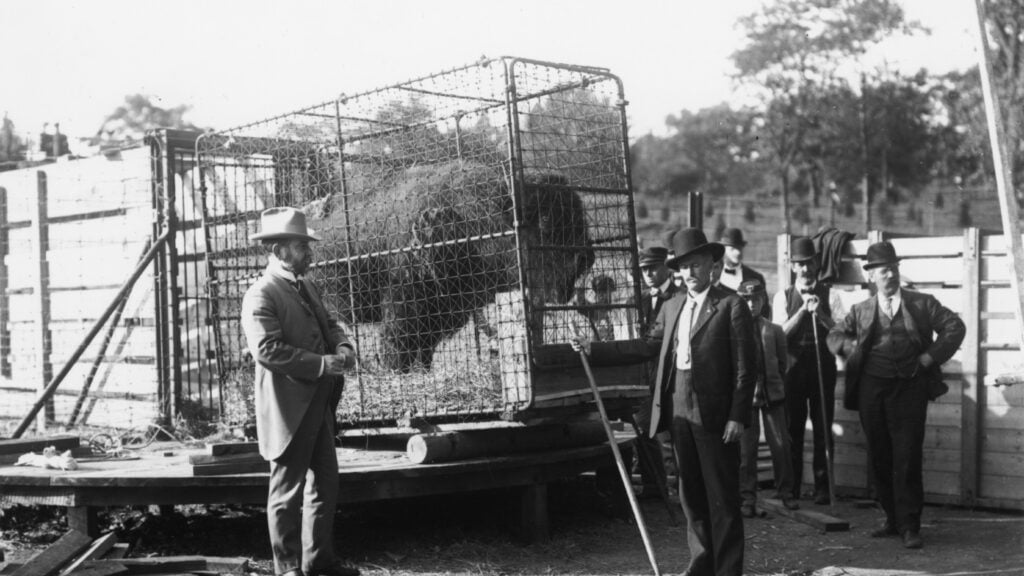
- Year Started: 1895
- Place of Origin: United States
- Founder and Leadership: Andrew H. Green, Henry Fairfield Osborn, and Madison Grant
- Objectives: To conserve the world’s wildlife and wild places through science, field-based conservation initiatives, and engagement with local communities.
The Wildlife Conservation Society (WCS) holds a distinguished place in the realm of wildlife conservation. The organization’s enduring significance lies in its century-old commitment to the protection of wildlife and wild places. They are fruitfully addressing the challenges of biodiversity loss, habitat degradation, and also the conservation of iconic species across the globe.
WCS plays a vital role in conserving the world’s biodiversity through science, field research, and community engagement. Its mission encompasses wildlife protection, habitat conservation, and also the promotion of sustainable practices that balance human needs with the preservation of diverse ecosystems. Therefore, it has earned its place among the 20 major environmental movements of the world.
Activities and Initiatives
- Field Conservation Programs: WCS conducts field conservation programs in diverse ecosystems, working closely with local communities and governments. These initiatives focus on protecting endangered species, preserving critical habitats, and mitigating threats such as poaching and habitat loss.
- Scientific Research: The organization engages in cutting-edge scientific research to understand wildlife behaviour, ecology, and the impacts of human activities on ecosystems. This research informs conservation strategies and contributes to global knowledge about biodiversity.
- Global Conservation Campaigns: WCS runs global campaigns to address overarching conservation challenges such as illegal wildlife trade, climate change impacts, and the establishment of protected areas. These campaigns aim to influence policies and promote international collaboration for effective conservation.
- Community Engagement and Education: WCS recognizes the importance of involving local communities in conservation efforts. Through community engagement and educational programs, the organization strives to build awareness, foster environmental stewardship, and ensure that conservation benefits both people and wildlife.
Major Achievements
- Establishment of Protected Areas: WCS has played a key role in the creation and management of protected areas worldwide. They significantly contribute to the conservation of diverse ecosystems and the protection of numerous species.
- Species Conservation Successes: The organization has been instrumental in the recovery of several species from the brink of extinction. Species include American bison, Siberian tiger, and mountain gorilla.
- Influencing Conservation Policies: WCS has actively influenced the development of conservation policies at national and international levels. In addition, they advocate for stronger protections for wildlife and their habitats.
3. BirdLife International

- Year Started: 1922
- Place of Origin: United Kingdom
- Founder and Leadership: T. Gilbert Pearson, Jean Théodore Delacour, and David Attenborough
- Objectives: To safeguard bird species and their habitats worldwide, using science-based conservation, local community engagement, and advocacy to prevent the extinction of bird species.
BirdLife International originated from a shared concern among early conservationists about the widespread threats faced by bird species. Originally established as the International Council for Bird Protection, which later evolved into BirdLife International. The organization holds profound significance as a global alliance dedicated to the conservation of birds and their habitats. BirdLife International’s enduring legacy lies in its commitment to safeguarding avian biodiversity and promoting sustainable practices for the benefit of both birds and humanity.
BirdLife International serves a critical role as the world’s largest partnership for bird conservation. Its mission is to conserve global bird diversity, prevent the extinction of endangered species, and ensure the sustainable use of natural resources for the well-being of both avian populations and human communities. Hence, it has rightfully earned its position among the 20 major environmental movements of the world.
Activities and Initiatives
- Conservation Programs: BirdLife International coordinates conservation programs worldwide, partnering with local organizations to implement initiatives aimed at protecting critical bird habitats, restoring ecosystems, and addressing threats such as habitat loss and climate change.
- Important Bird and Biodiversity Areas (IBAs): The organization identifies and designates IBAs, key sites for bird conservation around the world. These areas serve as focal points for conservation efforts, emphasizing the interconnectedness of healthy ecosystems and thriving bird populations.
- Advocacy for Bird-Friendly Policies: BirdLife International advocates for policies that promote bird-friendly practices, sustainable land use, and the protection of migratory routes. The organization actively engages with governments, industries, and communities to influence positive change for bird conservation.
- Scientific Research and Monitoring: The organization conducts scientific research and bird monitoring programs, providing valuable data on bird populations. This significantly contributes to the understanding of the ecological processes that support avian life.
Major Achievements
- Expansion of Protected Areas: BirdLife International’s efforts have contributed to the establishment and expansion of protected areas worldwide, ensuring the conservation of critical habitats for birds.
- Species Recovery: The organization has played a crucial role in the recovery of several endangered bird species by employing targeted conservation strategies to reverse population declines.
- Policy Impact: BirdLife International has influenced the development of national and international policies related to bird conservation, biodiversity, and habitat protection.
4. The Wilderness Society
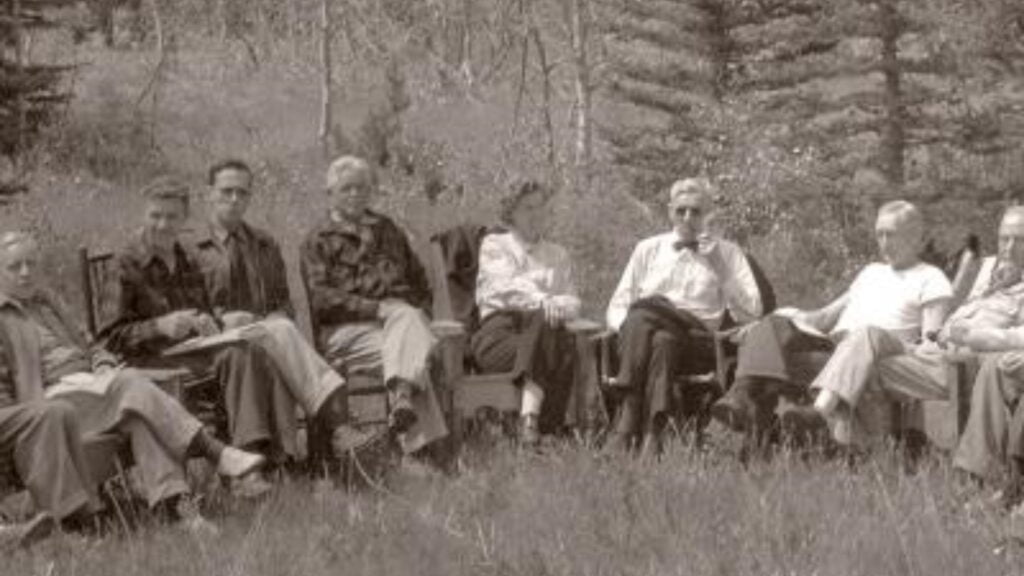
- Year Started: 1935
- Place of Origin: United States
- Founder and Leadership: Bob Marshall, Aldo Leopold, and Benton MacKaye
- Objectives: To advocate for the conservation of public lands, wildlife habitats, and natural landscapes.
The Wilderness Society emerged during a critical period in American history when concerns about the impact of industrialization on the nation’s natural landscapes were growing. Inspired by a shared vision of preserving untouched wilderness, the founders united to create an organization dedicated to the protection and stewardship of wild places.
The Wilderness Society holds a venerable place in the environmental movement, advocating for the protection of wild and pristine landscapes across the United States. With a rich history rooted in the early conservation efforts of visionaries like Bob Marshall and Aldo Leopold, the organization is significant for its dedication to preserving America’s wilderness for future generations.
The Wilderness Society plays a pivotal role in preserving and defending wild places. The organization’s mission revolves around safeguarding public lands, promoting sustainable land management, and also advocating for policies that balance conservation with recreational and economic interests. Therefore, it has rightfully earned its place among the 20 major environmental movements of the world.
Activities and Initiatives
- Advocacy for Wilderness Protection: The Wilderness Society actively engages in campaigns and lobbying efforts to secure the designation of wilderness areas. Moreover, these areas are afforded the highest level of protection, preserving their natural and ecological values.
- Public Lands Stewardship: The organization works to ensure responsible and sustainable management of public lands. This includes advocating for policies that protect ecosystems, wildlife habitats, and scenic values while allowing for compatible recreational uses.
- Legislative Initiatives: The Wilderness Society participates in the development and promotion of legislation that advances conservation goals. This includes supporting bills that establish new wilderness areas, strengthen environmental regulations, and address emerging threats to public lands.
- Educational Programs: The organization engages in educational initiatives to raise awareness about the value of wilderness and the need for conservation. These programs aim to foster a deeper understanding of the ecological, recreational, and cultural importance of wild places.
Major Achievements
- Establishment of Wilderness Areas: The Wilderness Society has played a crucial role in the establishment of numerous wilderness areas across the U.S., ensuring the protection of diverse ecosystems, wildlife habitats, and natural landscapes.
- Landmark Conservation Legislation: The organization has been involved in advocating for landmark conservation legislation, including the Wilderness Act of 1964. This legislation created the National Wilderness Preservation System and set the framework for protecting designated wilderness areas.
- Protection of Threatened Ecosystems: The Wilderness Society’s advocacy efforts have contributed to the protection of threatened ecosystems, preventing destructive development and preserving the integrity of critical habitats.
5. Australian Conservation Foundation

- Year Started: 1965
- Place of Origin: Australia
- Founder and Leadership: Sir Garfield Barwick
- Objectives: To protect the country’s environment through campaigns, research, and community engagement, promoting sustainability and biodiversity conservation.
The Australian Conservation Foundation (ACF) has been a stalwart advocate for environmental preservation and sustainability across the vast landscapes of Australia. The organization has played a pivotal role in shaping environmental policies, promoting conservation, and also fostering a connection between Australians and the unique ecosystems that define their continent.
The ACF was founded during a time of growing awareness about the environmental impacts of industrialization and urbanization in Australia. With a vision rooted in conservation and environmental protection, the organization aimed to address the challenges posed by rampant development and the depletion of natural resources. Thus, it has rightfully secured its spot among the 20 significant environmental movements of the world.
Activities and Initiatives
- Diverse Advocacy and Conservation Initiatives: The ACF engages in diverse advocacy efforts, addressing issues such as biodiversity loss, climate change, and the preservation of Australia’s iconic landscapes. In addition, the organization has been instrumental in campaigns related to the Great Barrier Reef, ancient forests, and the protection of unique wildlife.
- Protection of Biodiversity and Natural Heritage: Central to the ACF’s mission is the protection of Australia’s rich biodiversity. The organization actively works to preserve unique ecosystems and prevent habitat destruction. In addition, they advocate for policies that balance development with the conservation of diverse plant and animal species.
- Policy Advocacy and Legal Initiatives: The ACF employs a multifaceted approach to environmental conservation, combining policy advocacy with legal initiatives. By engaging with lawmakers, the organization seeks to influence legislation that addresses environmental concerns. Legal actions are pursued when necessary to protect Australia’s natural heritage.
- Renewable Energy and Climate Action: In response to the global climate crisis, the ACF has become a prominent advocate for renewable energy and climate action. Moreover, the organization promotes sustainable energy solutions, works to reduce Australia’s carbon footprint, and urges the government to adopt policies that align with international climate goals.
- Community Engagement and Public Awareness: In addition to policy and legal realms, the ACF recognizes the importance of community engagement and public awareness. The organization conducts educational initiatives, community outreach programs, and also public campaigns to foster a sense of responsibility and connection to the environment among Australians.
Major Achievements
- Despite several challenges, ACF helps in the protection of significant natural areas and the promotion of sustainable practices.
- ACF played a significant role in the establishment of the Great Barrier Reef Marine Park Authority in 1975.
- ACF’s efforts contributed to the recognition of the Great Barrier Reef as a UNESCO World Heritage site, highlighting the importance of protecting this iconic natural wonder.
6. Greenpeace

- Year Started: 1971
- Place of Origin: Vancouver, Canada
- Founder and Leadership: Bob Hunter, Irving Stowe, Dorothy Stowe, Ben Metcalfe, Marie Bohlen, Ben Metcalfe, and others
- Objectives: Protect the environment, combat climate change, conserve biodiversity, hold corporations accountable and promote sustainable agriculture. In addition, they oppose nuclear energy and work towards ocean conservation through peaceful activism.
It was inspired by a non-violent protest against the US government’s nuclear weapons test on Amchitka Island, Alaska, in 1971. A small group of activists chartered a boat called the Phyllis Cormack to sail to Amchitka and bear witness to the nuclear test. The crew included Irving and Dorothy Stowe, Ben Metcalfe, Marie Bohlen, and Bob Hunter.
They were unsuccessful in preventing the nuclear test. However, the journey sparked the idea of forming an organization that could engage in direct action to address environmental issues. The name Greenpeace was coined by Irving Stowe, symbolizing the organization’s commitment to promoting peace and environmentalism.
Greenpeace’s significance lies not just in its environmental advocacy but in its unwavering commitment to non-violence, independence, and bearing witness to environmental degradation. Its mission encompasses peace, environmental protection, and a deep-rooted belief in the power of direct action. As a result, it stands rightly acknowledged within the 20 key environmental movements of the world.
Activities and Initiatives
- Dynamic Campaigns: They attempt to address environmental issues such as climate change, deforestation, overfishing, pollution, and nuclear power. Through extensive research, creative campaigns, and eye-catching actions, the organization aims to ignite public consciousness and prompt policy changes.
- Save the Whales Campaign: Images of activists confronting whaling vessels resonated globally, contributing to a 1986 moratorium on commercial whaling.
- Rainforest protection: They conduct extensive research to document deforestation and its causes, utilizing field investigations and satellite monitoring. Moreover, advocacy and awareness campaigns are employed to inform the public and policymakers about the ecological significance of rainforests.
- Nuclear disarmament: They run campaigns, organize protests and advocate for the elimination of nuclear weapons.
- Arctic drilling protests: The organization urges governments and oil companies to reconsider their plans to protect the fragile Arctic ecosystem.
Major Achievements
- Nuclear Testing: The organization’s protests and campaigns contributed to the end of atmospheric nuclear testing by major powers, including the United States, the Soviet Union, and France.
- Anti-Whaling Campaigns: Their efforts, including high-profile confrontations on the high seas, contributed to the International Whaling Commission’s moratorium on commercial whaling in 1986.
- Ozone Layer Protection: Greenpeace played a key role in the successful campaign to phase out chlorofluorocarbons, contributing to the Montreal Protocol in 1987.
- Climate Change Awareness: The organization has played a role in mobilizing public opinion and pushing for policy changes to reduce carbon emissions.
- Campaigns Against Nuclear Weapons: Their efforts contribute to the broader global movement for a world free of nuclear weapons.
- Renewable Energy Advocacy: The organization promotes the development and adoption of clean energy technologies while campaigning against fossil fuels and unsustainable energy practices.
- Arctic Protection: The organization’s actions draw attention to the potential environmental risks and contribute to the broader dialogue on Arctic conservation.
7. Ocean Conservancy

- Year Started: 1972
- Place of Origin: United States
- Founder and Leadership: Peter Benchley and Nancy Dolphin
- Objectives: To engage governments, businesses, communities, and also individuals to implement science-based solutions and policies to protect and restore ocean ecosystems.
Ocean Conservancy traces its origins to a collective vision among a group of passionate individuals who recognized the urgent need to address the mounting threats to ocean health. Inspired by a commitment to ocean advocacy and driven by a desire to bridge the gap between science and policy. For the same reason, the founders set out to establish an organization dedicated to the preservation of marine ecosystems.
Ocean Conservancy stands as a beacon for marine conservation, addressing critical issues such as overfishing, plastic pollution, and the protection of ocean ecosystems. With a founding vision centred on ocean advocacy, the organization has played a crucial role in raising awareness about the health of the oceans and also advocating for policies that promote sustainable practices.
Ocean Conservancy fulfils a pivotal role in safeguarding the world’s oceans, advocating for sustainable and science-based solutions to the challenges they face. The organization also serves as a bridge between scientific research and policy-making, aiming to ensure the long-term health and vitality of marine ecosystems. Therefore, it rightfully occupies a space within the recognized 20 major environmental movements of the world.
Activities and Initiatives
- International Coastal Cleanup: Ocean Conservancy organizes the annual International Coastal Cleanup. This is one of the world’s largest volunteer efforts for ocean health. On this occasion, millions of volunteers globally participate in removing plastic debris and other pollutants from beaches and waterways.
- Fisheries Conservation: The organization actively engages in promoting sustainable fisheries management. They collaborate with fishermen, policymakers, and also with industry stakeholders to develop solutions that balance the needs of communities with the imperative of preserving fish populations and ecosystems.
- Marine Debris Solutions: Ocean Conservancy addresses the pervasive issue of marine debris, particularly plastic pollution. The organization works towards mitigating the impact of plastic on marine life through initiatives focused on reducing single-use plastics, promoting recycling, and advocating for policies to combat plastic pollution.
- Policy Advocacy: Through research and direct engagement with policymakers, Ocean Conservancy advocates for evidence-based policies that address the root causes of marine degradation. This includes advocating for marine protected areas, climate resilience, and sustainable ocean management.
Major Achievements
- International Coastal Cleanup Impact: The International Coastal Cleanup, initiated by Ocean Conservancy, has engaged millions of volunteers worldwide. The activities led to the removal of millions of pounds of trash from coastlines. They are also contributing to increased awareness about marine debris.
- Advancements in Sustainable Fisheries: The organization has played a key role in promoting sustainable fisheries management practices. These activities are significantly contributing to the solutions that balance the needs of the fishing industry with preserving ocean biodiversity.
- Leadership in Plastic Pollution Reduction: Ocean Conservancy’s efforts to combat plastic pollution have influenced public perception and policy discussions on single-use plastics. The organization has been instrumental in advocating for plastic reduction policies at national and international levels.
8. Chipko Movement

- Year Started: 1973
- Place of Origin: India
- Founder and Leadership: Sunderlal Bahuguna
- Objectives: To oppose deforestation, promote sustainable forestry practices, empower local communities, challenge corporate interests, and raise awareness about the interconnectedness of forests and human well-being.
The government permitted a company to cut down trees to make sports goods. A local environmentalist named Sundarlal Bahuguna and women from the Mandal village (Uttrakhand) protested against the deforestation in the area. They hugged the trees to stop loggers from cutting them down. This peaceful protest was noticed and was the start of the Chipko Movement.
The movement was inspired by the Bishnoi Movement of Khejarli, Rajasthan, India. A local maharaja ordered the cutting of trees in the year 1731 for the construction of a new palace. In protest, a Bishnoi woman named Amrita Devi hugged a tree and declared that it could only be felled over her dead body. In a tragic turn of events, she, along with many other Bishnois, was killed in the process. This event is considered a pivotal moment in Bishnoi’s history, symbolizing its commitment to environmental protection.
The movement was triggered by the growing concerns about deforestation. The rural communities in the region heavily depended on the forests for their livelihoods. Whereas, the government’s decision to grant logging contracts to commercial entities threatened the local ecosystem and the traditional way of life.
The movement quickly spread to other parts of the region, and women played a central role. The participants used peaceful protests and slogans to draw attention to the environmental degradation caused by deforestation. Thereafter, the Chipko Movement received widespread support and captured the imagination of people nationally and internationally. Therefore, it rightfully occupies a space within the recognized 20 major environmental movements of the world.
Activities and Initiatives
- Sustainable Forestry and Conservation: The Chipko Movement aimed to tackle the harmful effects of deforestation. Activists hugged trees set for cutting to emphasize the need for sustainable forestry, promoting conservation intertwined with local ecosystems.
- Women as Guardians of the Environment: A unique aspect of the Chipko Movement was the significant role of women in protests. Since women are most affected by environmental harm, they became the main protectors of forests. This emphasized the connection between environmental and social issues, also empowering women as environmental stewards.
- Gandhian Principles and Peaceful Resistance: Inspired by Mahatma Gandhi’s non-violent philosophy, the Chipko Movement used peaceful resistance to defend the environment. Villagers, including men, women, and children, hugged trees marked for logging, creating a powerful symbol of their dedication to nature.
Major Achievements
- The Chipko Movement successfully stopped deforestation in many places. Thereafter, the protests made the Indian government rethink its forestry rules, focusing more on community-based and sustainable practices. Because of the larger extent of the impact it went beyond India, inspiring global environmental activism.
- Because of the movement, the government changed its policies. In 1980, a 15-year logging ban was put in place in the region. They also introduced community-based forestry management, letting local communities take part in conserving and using forest resources sustainably.
9. Green Belt Movement

- Year Started: 1977
- Place of Origin: Kenya
- Founder and Leadership: Wangari Maathai (Nobel Peace Prize laureate)
- Objectives: To promote environmental conservation, empower women through tree-planting, and foster community development. In addition, advocate for human rights, raise awareness through education, and promote good governance and sustainable resource management for a more equitable and sustainable future.
Wangari Maathai founded the Green Belt Movement (GBM) in response to the deforestation she witnessed in Kenya, exacerbated by both environmental degradation and social injustices. GBM holds profound significance as a grassroots environmental organization that seamlessly intertwines tree planting, conservation, and the empowerment of local communities.
The GBM plays a multifaceted role in environmental conservation and community development. Its mission revolves around afforestation, environmental conservation, women’s rights, and community empowerment. Through tree-planting initiatives and advocacy, GBM strives to combat deforestation, enhance biodiversity, and significantly improve the quality of life for communities. Therefore, it occupies a position in the top 20 major environmental movements of the world.
Activities and Initiatives
- Tree Planting Campaigns: At the core of GBM’s activities are its tree planting campaigns. By mobilizing communities, especially women, the movement aims to counteract deforestation, combat soil erosion, and promote sustainable land use practices.
- Women’s Empowerment: GBM places a strong emphasis on empowering women. By involving them in tree planting and sustainable resource management, the movement enhances their role in environmental conservation and economic development.
- Advocacy for Environmental Justice: They actively engage in advocacy for environmental justice. This includes highlighting the interconnectedness between healthy ecosystems, social well-being, and sustainable development. Through educational programs, GBM also promotes awareness about the importance of conservation.
- Capacity Building and Education: The movement focuses on capacity building within communities. This includes providing training on sustainable practices, natural resource management, and environmental education. It significantly empowers individuals to take an active role in the conservation and sustainable use of their local environments.
Achievements
- Millions of Trees Planted: The Green Belt Movement has overseen the planting of millions of trees, contributing significantly to reforestation efforts in Kenya and beyond.
- Women’s Empowerment: GBM’s focus is on involving women in environmental initiatives and they have significantly empowered countless women. They help to enhance their economic independence and also leadership roles in their communities.
- Policy Influence: The movement’s advocacy efforts have influenced policies related to environmental conservation, sustainable development, and also women’s rights in Kenya.
10. Surfrider Foundation

- Year Started: 1984
- Place of Origin: United States
- Founder and Leadership: Glenn Hening and Lance Carson
- Objectives: To protect and preserve the world’s oceans, waves, and beaches.
Surfrider Foundation emerged from a shared concern among surfers and environmentalists who witnessed the degradation of coastal environments. Motivated by a desire to protect the oceans and waves they loved, the founders united to create an organization that could effectively address the pressing issues threatening coastal ecosystems.
The Surfrider Foundation has been a leading force in coastal conservation, advocating for the protection of oceans, waves, and beaches. The organization holds immense significance in its dedication to preserving coastal ecosystems, addressing pollution, and championing the rights of beachgoers and surfers
Surfrider Foundation plays a pivotal role in defending coastal environments through a mission that combines grassroots activism, scientific research, and policy advocacy. With a focus on protecting oceans and beaches, the organization strives to ensure the sustainable use and enjoyment of coastal resources. Therefore, it rightfully occupies a space within the recognized 20 major environmental movements of the world.
Activities and Initiatives
- Beach Cleanup Programs: Surfrider Foundation organizes numerous beach cleanup initiatives globally. They mobilise communities to remove litter and plastic debris from coastlines. These efforts aim to raise awareness about the impacts of pollution on marine life and ecosystems.
- Water Quality Monitoring: The organization conducts water quality monitoring programs to track pollution levels in coastal waters. Through scientific research and data collection, the Surfrider Foundation advocates for policies that improve water quality and protect public health.
- Rise Above Plastics Campaign: The organization advocates for reducing single-use plastics. To achieve this they started promoting recycling and raising awareness about the impact of plastics on marine environments.
- Coastal Preservation and Access: They work to protect coastal ecosystems from overdevelopment and pollution. The organization advocates for the preservation of natural shorelines and public beach access, ensuring that coastal areas remain accessible to the public.
Major Achievements
- Advocacy for Clean Water: The Surfrider Foundation has successfully advocated for policies and regulations that improve water quality at beaches, ensuring the safety of beachgoers and surfers.
- Coastal Preservation Campaigns: The organization has been instrumental in campaigns to protect coastal areas from excessive development, preserve natural habitats and also to maintain the integrity of coastal ecosystems.
- Plastic Reduction Policies: The Surfrider Foundation’s efforts have contributed to the adoption of plastic reduction policies at local and national levels. This influences businesses and also communities to reduce their reliance on single-use plastics.
11. Narmada Bachao Andolan

- Year Started: 1985
- Place of Origin: India
- Founder and Leadership: Medha Patkar
- Objectives: To oppose large-scale dam projects on the Narmada River, advocating for the rights of affected communities, sustainable development, and environmental preservation through nonviolent resistance.
The movement primarily focuses on constructing large dams along the Narmada River, one of the longest rivers in India, as part of the Narmada Valley Development Project. The proposed dam projects, including the Sardar Sarovar Dam, were designed to address issues of water scarcity, generate hydroelectric power, and also to facilitate agricultural development in the region. However, the construction of these dams threatened the displacement of numerous communities, especially tribal populations, whose homes and livelihoods were in the path of the reservoirs.
The Narmada Bachao Andolan, meaning Save the Narmada Movement, was a grassroots effort. The movement aimed to draw attention to the environmental and social consequences of the dam projects, advocating for the rights of those who would be adversely impacted. Therefore, it has earned its place among the 20 major environmental movements of the world.
Activities and Initiatives
- Indigenous Rights and Environmental Consequences: The movement emphasized the adverse environmental consequences of large dams. This includes displacement, loss of biodiversity, and the disruption of traditional livelihoods. Activists argued for alternative, sustainable solutions that respected the river’s ecological balance.
- Non-Violent Resistance and Satyagraha: The NBA engaged in satyagraha, or non-violent resistance, against the dam projects. On this occasion, many villagers including women and children, participated in protests, hunger strikes, and peaceful demonstrations to highlight the injustices faced by those slated for displacement.
- Legal Battles and International Attention: The NBA took its fight to the courts, challenging the legality and ethicality of the dam projects. Thereafter, the movement gained international attention, drawing support from environmentalists, human rights activists, and organizations advocating for indigenous rights.
Major Achievements
- The movement prompted a reassessment of dam policies. This led to increased scrutiny and a focus on balancing development with protecting indigenous communities and the environment.
- The movement influenced policy changes, leading to improvements in rehabilitation and resettlement policies. It also underscored the importance of considering environmental and social impacts in large infrastructure projects.
12. Rainforest Action Network

- Year Started: 1985
- Place of Origin: United States
- Founder and Leadership: Randy Hayes and Mike Roselle
- Objectives: To protect the world’s rainforests and the rights of indigenous communities by campaigning against deforestation, promoting corporate accountability, and also advocating for sustainable and socially just solutions to environmental challenges.
Rainforest Action Network (RAN) emerged from the shared concern of its founders about the escalating threats to rainforests and the communities dependent on them. United by a commitment to direct action and strategic advocacy, the founders established RAN to confront the root causes of rainforest destruction.
RAN holds profound significance as a grassroots organization committed to preserving forests, biodiversity, and the rights of indigenous communities. RAN’s origins lie in the urgent need to address deforestation, climate change, and the social injustices associated with resource extraction and logging in rainforest regions.
The RAN plays a vital role in challenging corporate practices that contribute to deforestation and environmental degradation. Its mission centres on advocating for sustainable forestry and protecting the rights of frontline communities. Thus, it has rightfully secured its spot among the 20 significant environmental movements of the world.
Activities and Initiatives
- Corporate Accountability Campaigns: RAN engages in high-impact campaigns targeting corporations contributing to deforestation. Through advocacy, protests, and dialogue, the organization pressures companies to adopt sustainable practices and halt environmentally destructive activities.
- Deforestation-Free Supply Chains: RAN advocates for companies to adopt deforestation-free supply chain commitments, encouraging sustainable sourcing of commodities such as palm oil, soy, and timber. The organization works to hold companies accountable for their environmental and social impacts.
- Indigenous Rights and Land Defense: Recognizing the vital role of indigenous communities as stewards of the rainforests, RAN actively supports efforts to defend their land rights. This includes advocating for the recognition of land tenure, resisting land grabs, and promoting community-led conservation.
- Climate Activism: RAN connects deforestation and climate change, highlighting the role of intact forests in sequestering carbon. The organization also advocates for policies that address the drivers of deforestation as a key strategy in the fight against climate change.
Major Achievements
- Corporate Policy Changes: RAN’s campaigns have led to significant policy changes by corporations. This includes commitments to zero deforestation, sustainable sourcing, and the protection of indigenous rights.
- Preserving Critical Ecosystems: The organization’s efforts have contributed to the preservation of critical rainforest ecosystems, preventing the destruction of biodiversity-rich areas.
- Community Empowerment: RAN’s support for indigenous communities has empowered them to resist destructive activities on their lands and assert their rights as guardians of the rainforests.
13. Rainforest Foundation

- Year Started: 1989
- Place of Origin: Brazil
- Founder and Leadership: Musician Sting and his wife Trudie Styler along with the indigenous leader of the Kayapo people, Chief Raoni.
- Objectives: To protect rainforests and the rights of indigenous people
The Rainforest Foundation has been a steadfast advocate for the protection of rainforests and the rights of indigenous communities who call these vital ecosystems home. Despite many challenges, this global organization are tirelessly working to address deforestation, promote sustainable land use, and empower indigenous peoples.
The Rainforest Foundation was born out of a shared concern for the accelerating destruction of rainforests, particularly in South America, Africa, and Southeast Asia. Sting and Trudie Styler envisioned an organization that not only combats deforestation but also champions the rights of indigenous communities deeply connected to these threatened landscapes. Therefore, it has earned its place among the 20 major environmental movements of the world.
Activities and Initiatives
- Dual Mission: Conservation and Indigenous Rights: They are intertwining of conservation and the protection of indigenous rights. The organization recognizes the crucial role that indigenous communities play as stewards of the rainforest. They also strive to ensure their rights are respected, empowering them to resist encroachment and exploitation.
- Direct Support for Indigenous Communities: The Rainforest Foundation engages directly with indigenous communities. They are providing support for land rights, sustainable development, and initiatives that allow these communities to protect their ancestral lands. By empowering indigenous peoples, the organization enhances their capacity to resist external threats and advocate for sustainable forest management.
- Advocacy for Responsible Corporate Practices: They are recognizing the impact of corporate activities on rainforests. In addition, they advocate for responsible business practices. The organization works to hold corporations accountable for environmentally destructive practices. They are also urging the adoption of sustainable approaches that safeguard both the rainforest and the rights of indigenous communities.
- Global Campaigns and Partnerships: They are running campaigns on a global scale and forming partnerships to address deforestation. The organization strives to create comprehensive solutions that address the root causes of rainforest destruction through collaboration.
- Technology and Innovation for Conservation: They utilize innovative tools such as satellite monitoring and geospatial analysis to track deforestation. This data-driven approach enhances the organization’s ability to respond rapidly to emerging threats and advocate for stronger environmental protections.
Major Achievements
- Secured land rights for indigenous communities and influenced policies to protect rainforests.
- The Rainforest Foundation has elevated the fight against deforestation to new heights. By leveraging satellite imagery and advanced mapping tools, the organization monitors and responds to illegal logging activities.
- The Rainforest Foundation has significantly empowered a large number of indigenous communities. This is achieved by providing them with the necessary tools and also knowledge to defend their rights. This includes legal education, training in sustainable land management practices, and support for community-led initiatives.
14. Amazon Watch
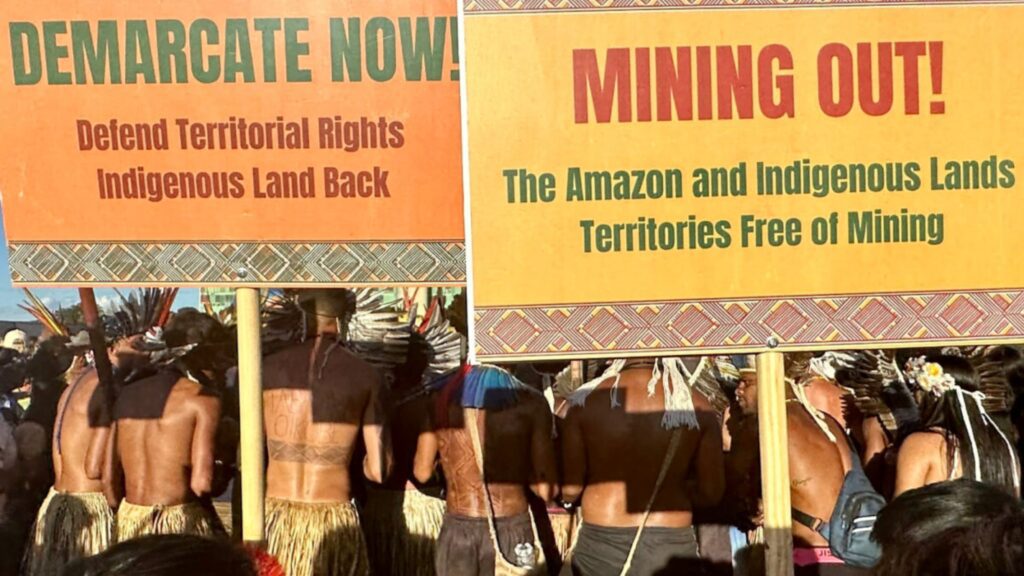
- Year Started: 1996
- Place of Origin: United States
- Founder and Leadership: Atossa Soltani
- Objectives: To protect the Amazon rainforest and the rights of its indigenous peoples.
Amazon Watch emerged in response to the escalating threats facing the Amazon rainforest and its indigenous inhabitants. Atossa Soltani founded the organization to provide a platform for indigenous voices to address environmental challenges and hold accountable those responsible for the destruction of one of the world’s most vital ecosystems.
Amazon Watch is an NGO with a primary focus on protecting the Amazon rainforest and supporting the rights of indigenous communities residing in the region. The significance of the organization lies in its commitment to addressing environmental issues, promoting sustainable practices, and advocating for the well-being of the Amazon and its diverse ecosystems.
The primary role of Amazon Watch is to act as a watchdog for the Amazon rainforest. They monitor and respond to threats such as deforestation, illegal logging, and industrial development. The organization collaborates with indigenous communities, local partners, and the global community to amplify their voices. They also advocate for policies that ensure the preservation of the Amazon and respect the rights of its inhabitants. Therefore, it occupies a position in the top 20 major environmental movements of the world.
Activities and Initiatives
- Deforestation Monitoring: Amazon Watch employs satellite technology and on-the-ground investigations to monitor and document deforestation activities in the Amazon. This data is used to raise awareness, inform policy discussions, and hold accountable those responsible for environmental degradation.
- Indigenous Rights Advocacy: The organization actively supports the rights of indigenous peoples in the Amazon. This includes advocating for land rights, cultural preservation, and protection from the impacts of extractive industries.
- Campaigns Against Dam Projects: Amazon Watch has been involved in campaigns opposing large-scale dam projects in the Amazon. The organization works to raise awareness about the impacts of these projects and also advocates for sustainable energy alternatives.
- Corporate Accountability: Amazon Watch engages with corporations involved in activities that contribute to deforestation or violate the rights of indigenous communities. The organization urges companies to adopt responsible and sustainable practices through public campaigns and direct dialogue.
Major Achievements
- Campaign Against Chevron-Texaco: Amazon Watch played a crucial role in supporting indigenous communities affected by oil contamination in the Ecuadorian Amazon. The organization worked alongside affected communities in their legal battles against Chevron-Texaco. They are also contributing to increased awareness and accountability for environmental damage.
- Support for Indigenous Land Rights: Amazon Watch has been successful in supporting various campaigns that resulted in legal recognition of indigenous land rights. This includes efforts to demarcate and protect territories from encroachment by logging, mining, and agricultural activities.
- Opposition to Mega-Dam Projects: Their advocacy against large dam projects in the Amazon has contributed to increased scrutiny and public awareness. This includes campaigns against projects like the Belo Monte Dam in Brazil, highlighting the potential environmental and social impacts.
15. Dogwood Alliance

- Year Started: 1996
- Place of Origin: United States
- Founder and Leadership: Danna Smith, Andrew Goldberg, and John Qua.
- Objectives: To promote sustainable forestry practices, protect biodiversity, and ensure the rights and well-being of local communities. It focuses on fostering a resilient and ecologically healthy future for Southern forests.
Dogwood Alliance emerged from a shared concern among its founders about the unsustainable logging practices threatening Southern forests. They established the alliance to confront the ecological and social challenges facing these vital landscapes.
The Dogwood Alliance holds profound significance as an NGO dedicated to the protection of Southern forests in the United States. The organization’s origins are rooted in the need to address the threats posed by industrial logging. In addition, it promotes sustainable forestry and advocates for the rights of communities dependent on these vital ecosystems.
The Dogwood Alliance plays a pivotal role in advocating for the conservation of Southern forests. Its mission focuses on promoting sustainable forestry practices, preserving biodiversity, and also safeguarding the well-being of communities. Therefore, it has earned its place among the 20 major environmental movements of the world.
Activities and Initiatives
- Corporate Accountability Campaigns: Dogwood Alliance engages in campaigns targeting corporations contributing to the degradation of Southern forests. Through strategic advocacy and public awareness, the organization pressures companies to adopt sustainable sourcing practices and also cease destructive logging activities.
- Forest Protection Initiatives: The alliance actively works towards the preservation of critical forest ecosystems in the Southern United States. This includes efforts to establish protected areas and also resist activities that threaten the integrity of these landscapes.
- Community Empowerment: Recognizing the importance of local communities, Dogwood Alliance empowers them to be advocates for forest conservation. In addition, they collaborate with residents and frontline communities to amplify their voices in forest management decisions.
- Climate Resilience: Dogwood Alliance connects the dots between forest conservation and climate resilience. By preserving Southern forests, the organization contributes to carbon sequestration, biodiversity conservation, and the overall health of the region’s ecosystems.
Major Achievements
- Corporate Policy Changes: Despite many challenges, Dogwood Alliance’s advocacy has led to significant policy changes by corporations. This influences their practices towards more sustainable and environmentally responsible.
- Preservation of High-Value Ecosystems: The organization’s initiatives have contributed to the preservation of high-value ecosystems in the Southern United States.
- Community-Led Conservation: Their collaborative approach has empowered local communities to actively participate in the conservation of forests.
16. Great Barrier Reef Foundation

- Year Started: 1999
- Place of Origin: Australia
- Founder and Leadership: A group of individuals and organizations
- Objectives: To support and fund projects, research, and initiatives dedicated to the conservation, restoration, and sustainable management of the Great Barrier Reef.
The establishment of the Great Barrier Reef Foundation stems from a shared concern for the future of this natural wonder. Born out of collaborative efforts among diverse stakeholders, the Foundation embodies a commitment to collective action and innovative solutions to address the unprecedented challenges facing the Great Barrier Reef.
The Great Barrier Reef Foundation holds significant importance as a leading organization dedicated to the protection and preservation of the iconic Great Barrier Reef, the world’s largest coral ecosystem. The Foundation’s inception emerged from a collective recognition of the urgent need to address the complex challenges facing this natural wonder.
The Great Barrier Reef Foundation plays a pivotal role in supporting and implementing projects aimed at the conservation and resilience of the Great Barrier Reef. Its mission revolves around funding scientific research, fostering collaboration, and driving innovative solutions to safeguard the reef’s biodiversity, health, and ecological balance. Therefore, it occupies a position in the top 20 major environmental movements of the world.
Activities and Initiatives
- Scientific Research and Monitoring: The Foundation funds and supports scientific research initiatives focused on understanding the dynamics of the Great Barrier Reef ecosystem. This includes monitoring coral health, studying climate impacts, and identifying strategies for reef restoration.
- Coral Restoration Programs: In response to coral bleaching and other threats, the Foundation actively engages in coral restoration projects. This involves the cultivation of resilient coral species and the deployment of innovative techniques to enhance the reef’s ability to recover.
- Community Engagement and Education: The foundation invests in educational programs and initiatives that raise awareness about the Great Barrier Reef’s ecological value. By fostering a sense of stewardship, the organization also aims to inspire actions that contribute to the reef’s conservation.
- Innovative Solutions for Climate Resilience: The Foundation seeks out and supports innovative solutions that enhance the Great Barrier Reef’s resilience in the face of climate change. This includes projects focused on mitigating the impacts of rising sea temperatures and ocean acidification.
Major Achievements
- Investment in Scientific Research: The Foundation’s support has led to significant advancements in scientific understanding of the Great Barrier Reef. They are also contributing to global knowledge of coral ecosystems.
- Coral Restoration Success: The Foundation’s coral restoration programs have successfully cultivated and transplanted resilient coral species. These activities aid in the recovery of degraded reef areas.
- Community Awareness Impact: Through education and community engagement efforts, the Foundation has contributed to increased awareness about the importance of the Great Barrier Reef and the need for collective conservation efforts.
17. Environmental Justice Foundation
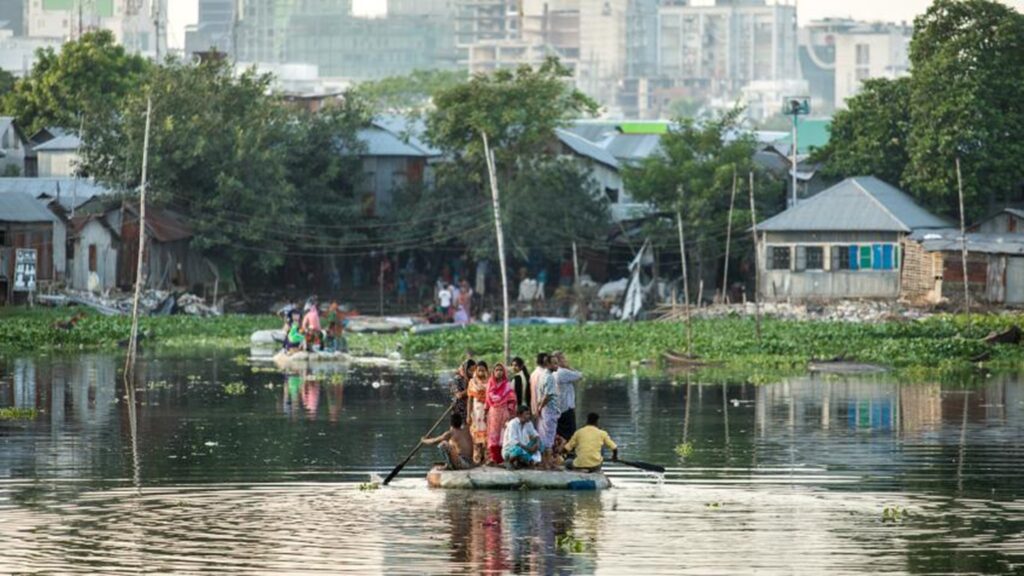
- Year Started: 2001
- Place of Origin: United Kingdom
- Founder and Leadership: Steve Trent and Juliette Williams
- Objectives: To address environmental and human rights issues worldwide by conducting investigations, advocating for policy change, and also working with affected communities.
Environmental Justice Foundation (EJF) emerged from the founders’ recognition of the link between environmental degradation, human rights abuses, and social injustice. The organization aims to address these interconnected issues, advocating for environmental justice and the rights of communities disproportionately affected by environmental harm.
EJF holds profound significance as an NGO dedicated to advocating for environmental justice, human rights, and the protection of vulnerable communities worldwide. EJF’s inception was driven by a commitment to address environmental abuses and ensure that all individuals, regardless of socio-economic status, have the right to a healthy environment.
The EJF plays a pivotal role in advocating for environmental justice on a global scale. Its mission centres on exposing environmental abuses, promoting sustainable practices, and also empowering communities to protect their natural resources and well-being. Therefore, it has earned its place among the 20 major environmental movements of the world.
Activities and Initiatives
- Investigation and Advocacy: EJF conducts in-depth investigations into environmental abuses (e.g. illegal fishing, deforestation and pollution). The organization uses its findings to advocate for policy changes, corporate accountability, and legal action to address environmental injustices.
- Protecting Oceans and Fisheries: The foundation focuses on combatting illegal, unreported, and unregulated (IUU) fishing. They are advocating for responsible fisheries management and also protecting the rights of vulnerable communities dependent on marine resources.
- Climate Justice: They are advocating for policies that mitigate climate-related threats and also supporting climate justice initiatives. They prioritize the most affected populations.
- Anti-Slavery and Human Rights: The foundation actively exposes and combats human rights abuses associated with environmental degradation. EJF advocates for ethical and transparent supply chains and also supports the rights of workers in industries contributing to environmental harm.
Major Achievements
- Exposing Illegal Fishing Practices: EJF’s investigations have led to the exposure of illegal fishing practices. They are prompting legal action against those involved and advocating for stronger international regulations.
- Promoting Sustainable Fashion: The foundation has been instrumental in highlighting environmental and human rights issues within the fashion industry. Despite several challenges, they are actively advocating for sustainable practices and ethical sourcing of materials.
- Advocacy for Climate Refugees: EJF’s work includes advocating for the rights of climate refugees. They are emphasizing the need for international recognition and protection for those displaced by climate-related events.
18. 350.org

- Year Started: 2008
- Place of Origin: United States
- Founder and Leadership: Bill McKibben and a group of students from Middlebury College in Vermont, USA
- Objectives: Advocate for climate action, promote fossil fuel divestment and mobilize global grassroots movements. They also facilitate a transition to renewable energy and empower communities.
350.org began with the launch of the International Day of Climate Action on October 24, 2009. On this day, people worldwide participated in over 5,200 events in 181 countries, all centred around the number 350. They often organize rallies and tree plantations to highlight the need to reduce carbon emissions for a sustainable climate future.
Its inception marked a pivotal moment in the fight against climate change, emphasizing a number that transcends mere statistics to embody a call for urgent action. Beyond its mission to address climate change, 350.org is distinguished by its core values of grassroots engagement, community mobilization, and a focus on the number 350 the safe concentration of CO2 in the atmosphere. The organization envisions a world where communities unite to combat climate change through collective, impactful action. Therefore, it occupies a position in the top 20 major environmental movements of the world.
Activities and Initiatives
- Global Campaigns: The organization engages community-led initiatives to international campaigns advocating for policies that reduce carbon emissions. The emphasis is on empowering communities to address the climate crisis at its roots.
- Global Movements and Impactful Actions: They facilitate uniting people across borders for a common cause. Its campaigns have mobilized millions worldwide, and iconic events like the Global Climate Strikes raise global awareness.
Major Achievements
- Global Agenda: 350.org has played a significant role in placing climate change on the global agenda.
- Persistent Advocacy: The movement’s advocacy has contributed to policy shifts, renewable energy initiatives, and increased public awareness.
- Navigate global climate policies: The 350 ppm target remains a rallying point for climate activists worldwide. Its commitment to grassroots mobilization often places it during debates on the balance between activism and dialogue.
19. Extinction Rebellion

- Year Started: 2018
- Place of Origin: United Kingdom
- Founder and Leadership: Roger Hallam and Gail Bradbrook
- Objectives: To declare a climate emergency, strive for net-zero carbon emissions by 2025, advocate for citizens’ assemblies, promote government accountability, address biodiversity loss, and employ nonviolent civil disobedience to draw attention to the urgency of climate action.
The movement garnered global attention in November 2018 during its first major campaign. It included civil disobedience, road blockades, and protests in central London. The activists demanded that governments declare a climate emergency and reduce greenhouse gas emissions to net zero by 2025. In addition, establish citizens’ assemblies to oversee climate policies.
Extinction Rebellion employs a decentralized organizational structure, utilizing social media and grassroots organizing to mobilize supporters. The movement follows civil disobedience principles inspired by figures like Mahatma Gandhi and Martin Luther. It emphasizes nonviolent protest to raise awareness and pressure governments into prioritizing climate action.
A seismic shift occurred in the environmental activism landscape with the emergence of Extinction Rebellion. Born out of deep concern for the planet’s future, this international movement uses civil disobedience as a powerful tool. Its goal is to demand urgent action against the escalating climate and ecological crisis. Extinction Rebellion’s foundation lies in principles of non-violent civil disobedience, direct action, and a sense of urgency. The movement argues that traditional avenues for change are not enough. It calls for a radical shift in the approach to tackle imminent threats to biodiversity and climate. Therefore, it has earned its place among the 20 major environmental movements of the world.
Activities and Initiatives
- Global Mobilization and Impact: Road blockades and symbolic acts of rebellion have resonated in major cities worldwide. Its iconic symbol, the XR hourglass, has become synonymous with the urgency of addressing ecological collapse.
- Diverse Leadership and Grassroots Involvement: They thrive on a decentralized structure with leadership emerging from various corners of the globe. The movement is driven by individuals from diverse backgrounds, reflecting a collective commitment to safeguarding the planet.
Major Achievements
- Global Acceptance: Governments and institutions have been compelled to respond to XR’s calls for urgent climate action. This has significantly contributed to a broader global conversation on the need for systemic change.
- Remain Resilient: It emphasises that the urgency of the climate crisis justifies unconventional tactics to break through societal inertia.
20. Fridays for Future

- Year Started: 2018
- Place of Origin: Sweden
- Founder and Leadership: Greta Thunberg
- Objectives: To demand urgent and effective climate action from governments and institutions worldwide to address the escalating climate crisis.
The spark for Fridays for Future was Greta’s frustration with the lack of political will to address the climate crisis. Greta sat alone outside the parliament building in Stockholm holding a sign of “Skolstrejk för klimatet” (School Strike for Climate). Her solitary act of defiance quickly gained attention and inspired other students around the world.
Fridays for Future emerged as a spontaneous response to the urgent need for climate action. Greta Thunberg’s solo strike evolved into a global phenomenon as young people around the world joined the movement. Further, it was fueled by a shared global concern for the future on a planet grappling with climate change.
The movement gained further momentum in September 2018, when Greta Thunberg spoke at the United Nations Climate Action Summit. Her powerful speech resonated globally, amplifying the call for immediate and substantial climate action. The Fridays for Future movement organized several large-scale global strikes. Millions of young students reached the streets to demand stronger environmental policies and adherence to the Paris Agreement. Therefore, it occupies a position in the top 20 major environmental movements of the world.
Activities and Initiatives
- Global Student Mobilization: Students around the world skip school every Friday to ask for better climate policies. The movement wants governments and institutions to take responsibility for causing the climate crisis.
- Symbolism and Impactful Actions: Fridays for Future has organized worldwide strikes, rallies, and events. This gives young people a chance to speak up and ask for serious actions to tackle climate change.
- Greta Leadership: Her powerful speeches and strong calls for action have made her a key figure in the climate movement. She has inspired millions of people to join protests and speak up for the environment.
- Demands and Advocacy: They want governments to follow the Paris Agreement goals. Fridays for Future aims to keep the global temperature increase under 1.5 degrees Celsius through advocacy.
Major Achievements
- The movement influenced policies, gained international recognition, and inspired millions to take part in climate activism. Despite challenges, FFF has significantly elevated the discourse on climate issues and prompted positive actions worldwide.
Conclusion
The listed environmental movements have played a very crucial role in shaping the world. Therefore, it occupies a position in the top 20 major environmental movements of the world. However, there are many other environmental movements which play an important role in the conservation of nature.
Despite of author’s diligent efforts, there may be some movements or instances where certain aspects or points have unintentionally been missed.

